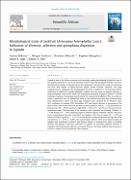| dc.contributor.author | Nakintu, Justine | |
| dc.contributor.author | Andama, Morgan | |
| dc.contributor.author | Albrecht, Christian | |
| dc.contributor.author | Wangalwa, Raphael | |
| dc.contributor.author | Lejju, Julius B. | |
| dc.contributor.author | Olet, Eunice A. | |
| dc.date.accessioned | 2023-10-06T20:12:50Z | |
| dc.date.available | 2023-10-06T20:12:50Z | |
| dc.date.issued | 2023-09-15 | |
| dc.identifier.citation | Nakintu, J., Andama, M., Albrecht, C., Wangalwa, R., Lejju, J. B., & Olet, E. A. (2023). Morphological traits of jackfruit (Artocarpus heterophyllus Lam.): indicators of diversity, selection and germplasm dispersion in Uganda. Scientific African, e01900. https://doi.org/10.1016/j.sciaf.2023.e01900 | en_US |
| dc.identifier.issn | 2468-2276 | |
| dc.identifier.uri | http://dir.muni.ac.ug/xmlui/handle/20.500.12260/571 | |
| dc.description.abstract | Uganda is one of the African countries with increasing production demands of jackfruit since it has gained popularity as a food and nutrition security crop with therapeutic benefits. However, the jackfruit germplasm in Uganda had not been adequately characterized to guide its production and there were reports of farmer-selection against inferior varieties. Therefore, this study comprehensively catalogued the morphological diversity of jackfruit to foster purpose-driven cultivation of jackfruit in Uganda; identified varieties and traits prone to negative selection to guide germplasm conservation efforts and established germplasm dispersion patterns to inform exchange programs of germplasm found suitable for commercial production. This was achieved using 47 qualitative and 30 quantitative traits of 249 jackfruit trees from four ethno-varieties, three administrative regions and three agro-ecological zones analyzed for the Shannon index (H'), coefficient of variation (CV), heritability (H2), and genetic advance as percentage of the mean (GAM). Seed surface color was the most variable qualitative trait (H' = 3.16) and number of fruits per tree (H2 = 99.83) and fruit weight (GCV = 69.45, PCV = 69.76) were the most diverse quantitative traits. Ethno-varieties of low economic value registered low diversity (Serebere: H' = 0.92, Namata: H' = 1.04), depicting negative selection against undesired varieties. The qualitative morphological diversity of jackfruit was highest in the Central region (H' = 1.07) and lowest in Eastern Uganda (H' = 1.02). Given the positive correlation between tree age and trunk circumference (r = 0.99, p = 0.001), the Central region with the oldest trees, largest trunks and samples with associations in Eastern and Western regions, is presumed the center of jackfruit diversity and pioneer of jackfruit cultivation in Uganda. In conclusion, jackfruit diversity in Uganda is still robust despite selection constraints. However, for future jackfruit improvements, it is vital to conserve the less preferred ethno-varieties. | en_US |
| dc.description.sponsorship | German Academic Exchange Service (DAAD). | en_US |
| dc.language.iso | en | en_US |
| dc.publisher | Elsevier | en_US |
| dc.subject | Agro-ecological zones | en_US |
| dc.subject | Crop improvement | en_US |
| dc.subject | Ethno-varieties | en_US |
| dc.subject | Germplasm conservation | en_US |
| dc.subject | Administrative region | en_US |
| dc.title | Morphological traits of jackfruit (Artocarpus heterophyllus Lam.): Indicators of diversity, selection and germplasm dispersion in Uganda | en_US |
| dc.type | Article | en_US |

